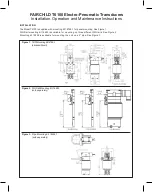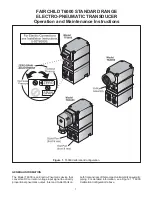
Appendix F: Redundant Backup with TP64 and TPT-2 Transfer Panels
F-9
Moseley SL9003Q
602-12016-01 Revision J
For use with the TPT-2, the Starlink transmitter NMS card requires modification for
compatible logic levels. Remove the NMS card. Install a 10K Ohms resistor for R33. Select
12V on Jumper E4. This entails cutting the trace between pins 1 and 2 and wiring between
pins 2 and 3 on E4.
F.4.3 Discrete Starlink with DSP6000 Backup using a TPT-2
Transmitter
: Figure F-6 shows a typical Starlink SL9003Q (STL) Main/Standby
configuration using a DSP6000/PCL series analog STL as backup.
The digital audio (AES/EBU) or analog audio lines can be split to both of the program inputs
through the use of wired XLR tees.
NOTE
: The transmitter audio encoder input impedance default is 10K Ohms so
paralleling the inputs with the tee is acceptable. If 600 Ohm termination is preferred
internal jumpers E2 & E5 must be set to 600 Ohms on the audio encoder of either the main
or the backup link but not both. Installing 600 Ohm termination will lower the audio level by
6 dB.
The RS-232 data control aux channel can be split to both transmitters through a “modem
splitter”. The splitter can be a passive device, such as Black Box P/N TLO73A-R2 (3 port,
MS-3).
In using the TPT-2 for this hybrid digital/analog backup configuration, the logic is such that
the PCL series STL must be connected to “TRANSMITTER A” as shown below in Figure F-5.
The TPT-2 allows you to select either “Transmitter A” or “Transmitter B” as the Main
Transmitter. Select “Transmitter B” as Main and “Transmitter A” as Backup to select the
Starlink as the main link.
Set the Starlink system to operate in Cold-Standby mode. In this mode the transmitter is
not radiating unless selected to correspond to the TPT-2 operation.
The Starlink-to-TPT-2 transfer control cable is available from Moseley for this configuration
(203-12225-01). However, a cable can be made from a shielded RJ-45 (Black Box P/N
EVNSL60-0006). This is a 6-foot cable that can be cut and the ends tinned to provide the
signals for the indicated connection. Be sure to maintain the shield performance by
connecting to ground. The high RF levels in typical STL receiver environments can cause
problems.
Summary of Contents for Starlink SL9003Q
Page 86: ...5 22 Section 5 Module Configuration Moseley SL9003Q 602 12016 01 Revision J ...
Page 90: ...6 4 Section 6 Customer Service Moseley SL9003Q 602 12016 01 Revision J ...
Page 110: ...A 10 Appendix A Path Evaluation Information Moseley SL9003Q 602 12016 01 Revision J ...
Page 118: ...D 2 Appendix D Microvolt dBm Watt Conversion 50 ohms Moseley SL9003Q 602 12016 01 Revision J ...













































